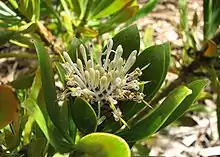Isopogon fletcheri
Isopogon fletcheri, commonly known as Fletcher's drumsticks,[2] is a species of plant in the family Proteaceae and is endemic to a restricted area in the Blue Mountains of New South Wales. It is a bushy shrub with narrow egg-shaped to narrow lance-shaped leaves with the narrower end towards the base, and top-shaped to egg-shaped heads of yellowish or creamy green flowers.
| Fletcher's drumsticks | |
|---|---|
 | |
| Isopogon fletcheri in Maranoa Gardens | |
| Scientific classification | |
| Kingdom: | Plantae |
| Clade: | Tracheophytes |
| Clade: | Angiosperms |
| Clade: | Eudicots |
| Order: | Proteales |
| Family: | Proteaceae |
| Genus: | Isopogon |
| Species: | I. fletcheri |
| Binomial name | |
| Isopogon fletcheri | |
 | |
| Occurrence data from Australasian Virtual Herbarium | |
Description
Isopogon fletcheri is an erect, bushy shrub that typically grows to a height of 1–1.5 m (3 ft 3 in–4 ft 11 in) and has glabrous reddish brown branchlets. Its leaves are narrow egg-shaped to narrow lance-shaped or linear with the narrower end towards the base, 40–120 mm (1.6–4.7 in) long and 5–20 mm (0.20–0.79 in) wide and more or less sessile. The flowers are arranged in top-shaped to egg-shaped, sessile heads 20–25 mm (0.79–0.98 in) long in diameter with overlapping egg-shaped involucral bracts at the base. The flowers are about 15 mm (0.59 in) long, yellowish to creamy green and glabrous. Flowering occurs from September to November and the fruit is a hairy oval nut 2–3 mm (0.079–0.118 in) long, fused with others in a more or less spherical cone up to 20 mm (0.79 in) in diameter.[3][4]
Taxonomy and naming
Isopogon fletcheri was first formally described in 1894 by Ferdinand von Mueller in Proceedings of the Linnean Society of New South Wales Series from specimens collected by Joseph James Fletcher from Blackheath, overlooking the Grose Valley.[5][6]
Distribution and habitat
Fletcher's drumsticks grows in forest within the spray zone of waterfalls near sandstone cliffs in a few places near Blackheath.[2][3][4][7]
Conservation status
This isopogon is classified as "vulnerable" under the Australian Government Environment Protection and Biodiversity Conservation Act 1999 and the New South Wales Government Biodiversity Conservation Act 2016. The main threats to the species include its small population size, restricted distribution, disease caused by Phytophthora cinnamomi, disturbance due to walkers and rock climbers, and weed invasion.[2][7]
Use in horticulture
This species is hardy when grown in well-drained soil, using low-phosphorus fertilisers. [8]
References
- "Isopogon fletcheri". Australian Plant Census. Retrieved 24 November 2020.
- "Approved Conservation Advice for Isopogon fletcheri (Fletcher's drumsticks)" (PDF). Australian Government Department of the Environment. Retrieved 24 November 2020.
- Foreman, David B. "Isopogon fletcheri". Australian Biological Resources Study, Department of Agriculture, Water and the Environment: Canberra. Retrieved 24 November 2020.
- Harden, Gwen J. "Isopgon fletcher". Royal Botanic Garden Sydney. Retrieved 24 November 2020.
- "Isopogon fletcheri". APNI. Retrieved 24 November 2020.
- von Mueller, Ferdinand (1894). "Description of a new Isopogon of New South Wales". Proceedings of the Linnean Society of New South Wales. 2. 9: 151–152. Retrieved 24 November 2020.
- "Fletcher's Drumsticks - profile". New South Wales Government Office of Environment and Heritage. Retrieved 24 November 2020.
- Feilen, Peter. "Isopogon fletcheri". Australian National Botanic Gardens. Retrieved 24 November 2020.
